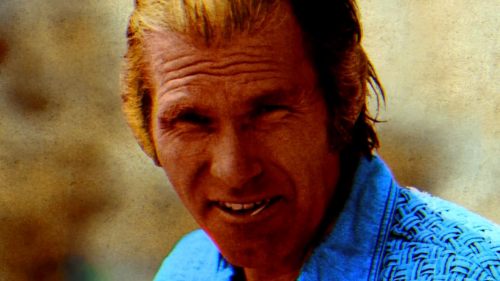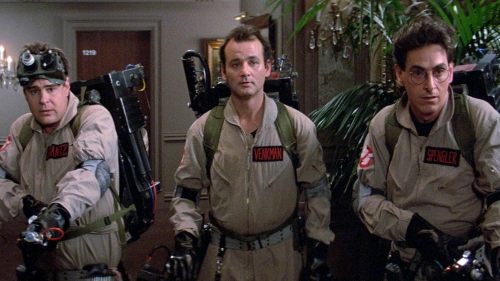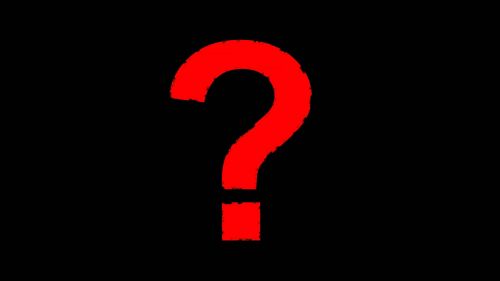Collins’ Crypt: The POLTERGEIST Sequels Are Finally Worth Seeing Again
I've mentioned before in previous Crypts that Poltergeist II: The Other Side was the first horror movie I ever saw in theaters (and that the original film was likely the very first horror movie I ever saw), so you might think it's odd that I never owned a copy of it as a kid. I didn't buy it on VHS or tape it off of HBO or anything like that - it wasn't until 2008, when I bought the double feature DVD of the two sequels, that I think I ever even watched the whole film again from start to finish. Perhaps that's why my nostalgia blinders - which should be very strong considering its "historic" significance in my life as a horror fan - don't cloud my judgment of the film: it's "fine", but a big step down from the original. And Poltergeist III isn't even as good as that, though it at least improves in the FX department, with in-camera (and often very hard to spot) tricks replacing the previous film's woefully sub-par optical work.
But what the films occasionally lack in their on-screen quality (though both are masterpieces compared to the 2015 remake), they more than make up for in fascinating production histories, which apart from Heather O'Rourke and Zelda Rubinstein are the only things that stuck around for all three films. Any horror fan knows about the so-called Poltergeist "curse", which was drummed up by superstitious types to explain the high number of deaths from the series, and it will come up again whenever another actor dies even if it's from old age. That a number of the deaths are tenuous at best (Julian "Reverend Kane" Beck died of the cancer he had before he even got the role, for example) doesn't really seem to matter to anyone who likes to spice up a slow news day by bringing up the "curse", but I won't deny it certainly encouraged more interest in the behind the scenes drama for all three films. Until now, we never really got much detail about them - the first film's "special edition" release has a documentary about real life ghost hunters and nothing else, and the two sequels got even less on their joint release (trailers, basically).
Naturally, Scream Factory has come to the rescue, at least for the sequels (which are controlled by MGM; Warner Bros still retains rights to the first film, and they're notoriously "eh" about releasing special editions for their library titles). Each film has been released with two commentaries, additional interviews, and for Poltergeist III, footage of the film's original ending, which has been a subject of controversy since the film was released in 1988. Anyone with half a brain would be able to spot that Heather O'Rourke's face is never shown in the film's closing minutes, and that's due to the fact that she tragically passed away after the film's original production, but before reshoots/pickups, necessitating the use of a double. And while The Other Side didn't have to deal with that ungodly situation, it too went through its share of obvious reworking, with a goofy/abrupt ending and some reshuffling of key scenes, resulting in glaring continuity errors (keep an eye on Tangina in the final scene - she completely vanishes at one point). For the first time, we're able to hear someone's side of the story at length on these matters, and for me (and presumably some of you), allowed me to finally get some legitimate enjoyment out of my time with these films.
Don't go looking for truly eye-opening dirt, however - these discs had to go through MGM legal, after all, so while there's plenty of nitty gritty you'd certainly never find on an EPK, everything is cordial and people only blame themselves for the films' lapses - rarely will they badmouth another person from the production. The commentaries have noticeable silent gaps on occasion, often whenever the conversation turns to original endings or other reshoots*, but plenty of good stuff makes it through. It's been 30 years, so there's a "water under the bridge" tone to the stories of rushed timeframes (screenwriter Brian Taggert apparently only had about ten days to write the third film) and miffed actors (Rubinstein was upset about a cut scene from Poltergeist II). Of course, backstage drama is a Poltergeist tradition - we will be debating about who really directed the first film until the end of time, and there was that unfortunate business with the real skeletons (they were cheaper than plastic ones, apparently), but the original film was seemingly released as envisioned and clearly didn't suffer from whatever issues might have come up between Hooper and Spielberg. The sequels, however, are a much different story.

Now, by nature, any sequel is subject to some overthinking and "too many cooks", but at least a good number of them have the major creative forces returning, and that may be why the Poltergeist sequels dropped so far in quality. Spielberg, Hooper, producers Frank Marshall and Kathleen Kennedy, and others all either declined or weren't asked to return for the sequel, and so the only major contributors to the first film (besides composer Jerry Goldsmith) that came back were Michael Grais and Mark Victor. However, that wasn't exactly something to point out in the marketing; they were the team who wrote the original screenplay (based on Spielberg's idea), though it was rewritten by Spielberg after that, and they didn't have much of a role in its production after turning in their draft. So while The Other Side is technically from the same writers, it's about the loosest possible example of the idea, and - nothing against the men - something WITH Spielberg is kind of always going to be better than something WITHOUT him. But hey, it was something, and they were able to get the core family of actors back minus Dominique Dunne, who was murdered in 1982 and thus her character (Dana, the oldest sister) was written out without any explanation in the final cut (there was a scene explaining that she was off at college, but it's not in the released version of the film - she is simply retconned out of existence, like Chuck Cunningham).
It's possible that the scene would have been left in had there not been so much tinkering, but what was once a 130-minute movie was released at a lean 90 - nearly a third of the film had been excised, though some material (including the references to Dana) were retained for the novelization. As for the aforementioned re-ordering of scenes, it's unclear if they would improve the film or not had they been shown in their intended order, but such things aren't done unless there's a panic of some sort. Fansite guru David Furtney (who provides commentary for both films) helpfully points out how the scenes were originally ordered, so any fans with a lot of time on their hands can recut the film as it was intended and find out - though they can't restore the original finale, as the footage isn't there, so we'll forever be stuck with the lame one we got. New director Brian Gibson wasn't around for the reshot ending (John Bruno directed it, thirteen years before boring us to death with Virus), which suffers from poor FX and a generally dull confrontation, allowing the audience to spend their final few minutes with the film (and, as it'd turn out, the Freeling family) alternating between laughing and being bored. It's a shame, too, because before the ending is a pair of terrific sequences that are every bit as good as the original: a sequence where Steven (Craig T. Nelson) is possessed by and then pukes up a giant worm, followed by a garage-set escape attempt with a flying chainsaw (an effect that looks better on Scream's Blu-ray than it did on DVD, shockingly enough - usually high def makes bad FX look even worse). Had the movie more or less ended there, it might have a better overall reputation, but instead we get this weirdo trip to the subtitular "Other Side" that seemingly no one likes (certainly not Grais, who expresses his dismay on his commentary track - his partner Mark Victor is MIA for whatever reason).
HR Giger is also less than thrilled with the finished product, as he designed some of the film's creatures but was not on hand to supervise their construction/execution as he was for Alien. Making matters worse, Gibson didn't quite understand the complexities of working with these kinds of effects, and so they'd be designed for certain angles/lighting which he would apparently change on the spot, necessitating quick (read: not ideal) adjustments and underwhelming "performances" from the creatures. Some of the accidents turned out well - the Kane-worm's creepy snarl when he looks at Steven and Diane was apparently not intentional but a misbehaving servo in the facial apparatus, for example - but this obviously created friction on the set, and was probably part of the reason Gibson wasn't involved when the studio decided the film needed more scary stuff. Luckily, their thinking seemed to be correct - the reviews weren't great, but audiences (including a very excited six-year-old BC!) flocked to the film in the summer of 1986, ultimately making it the year's highest grossing horror film, though it failed to generate as much box office at the original.
This fact was not lost on MGM, who wanted to continue the series but cut costs. Poltergeist III's budget was only around half of what The Other Side had, though they clearly got to save on cast costs: of the Freelings, only O'Rourke returned (with Rubinstein popping up for good measure). But they didn't recast (weird how MGM, who changes out James Bonds every decade, was seemingly unwilling to ever let anyone else play these roles besides the original actors), so the plot had O'Rourke sent to Chicago to attend a special school for gifted children, and living with her aunt (Nancy Allen as Patricia, a previously unmentioned sister to Diane Freeling) and uncle (Tom Skerritt). It's not the worst idea, as sequels go - the change of scenery was a big plus, and there's only so much they can do with the same characters going through the same situation - it'd be like if Holly got held hostage once again in Die Hard 3. Unfortunately, Grais and Victor (and Goldsmith) all moved on as well, making the two actors the only ones to have any previous connection to the series. The Freeling family is mentioned a few times (not Dana, of course), but even when Carol Anne disappears no one thinks to call her parents - it's the kind of sequel where you just have to accept that no one will behave logically because they can't include pre-existing characters who should have gotten involved.

One major change was actually for the better - the FX. Not wanting to deal with opticals, new director Gary Sherman (a bit of a horror guru thanks to the awesome Death Line and underrated Dead & Buried) wanted to do every effect in camera, using doubles and fake mirrors to pull off some truly impressive shots (this is one case where the Blu-ray's quality DOES hurt a bit - it's easier to spot the slight differences between Allen, Skerritt, etc. and their doubles, who are miming their movements). These shots are pretty much all the movie has going for it, but they were not that easy to pull off, and consumed a lot of the production's time (it went at least a week over schedule), which - along with the reduced budget - left them unable to complete major sequences as originally intended. On the commentary, Sherman points out several scenes (like the ones involving the group of teens that seemingly stepped out of a particularly bland slasher film) that are only in the movie because it'd be too short otherwise, and would have been trimmed or cut entirely if they had anything else they could use. If you ever wondered why the film was paced so awkwardly (the first 20 minutes are actually quite good, for what it's worth, then things start falling apart), that's the reason, or at least, the given one - the film runs 97 minutes, so they could have chucked some of this stuff and still been OK on the runtime. Listening to the commentary, I suspect Sherman (who has said repeatedly that this is his least favorite of his films) didn't care too much about the plot or even the pacing, and just focused all his energy on the trick shots. With the script being so wonky, I can't say I blame him - I'm still trying to understand why Allen's character is so much more loving and caring to her newly acquired stepdaughter (Lara Flynn Boyle, playing Skerritt's daughter from a previous marriage) than Carol Anne, who is her blood relative.
But at least it seems like it was a much more relaxed set than the previous film; they were working under the gun, but Sherman knew what he was doing and there were no major clashes among the actors (and Sherman is the only director! A Poltergeist first!). The real drama began after the film was shot, when O'Rourke's tragic and awful death (she was misdiagnosed with Crohn's disease, the medication caused a bowel obstruction, and she died during surgery to repair it) put them in a major bind that couldn't have been foreseen. Not only was the ending that they shot unsatisfying, it also had Carol Anne appear dead (frozen) at one point, which would have been far too ghastly for a film that was already going to have an unfortunate icky air to it (how do you market a movie about a little girl being terrorized when nearly all of the intended audience will know she died in real life?). So they had to reshoot it without her, resulting in an even less satisfying ending as it reduces the series' star to a mute who buries her face inside the arms of another character (another character, Donna's boyfriend Scott, disappears from the film entirely, as the actor wasn't involved with the reshoot and thus his character's fate is left unknown). And, not for nothing, but the story wasn't so great to begin with, and it wasn't helped by the fact that a new actor obviously had to stand in as Kane - the one time in this cast-ravaged series that they deemed it OK to hire a new actor to play an existing character. Nothing against this actor (Nathan Davis), but he's no Julian Beck, and as a result Kane, so terrifying in the previous film, has kind of a stiff, oft-muted presence here, like they were trying to keep the audience from realizing it was a different actor. Insult to injury, Davis was dubbed by the same guy who did some of Kane's voice on P2 (as Beck had passed away before doing his ADR), so he is made up to look like one actor while being voiced by another - the most thankless gig in history, I assume. Carol Anne's asshole teacher/therapist from the school, Dr. Seaton, is actually a better protagonist in the movie - but he unfortunately gets killed off with 30 minutes to go.
Basically, who the hell knows what kind of insanity they'd have to put up with if they ever made a proper Poltergeist IV, though we can be almost 100% sure it wouldn't be a very good movie. While all of the early deaths related to the series are tragic, the real curse of the series is that they could never even come close to matching the magic that Hooper and Spielberg created together with the original, but inexplicably kept trying. After the third film tanked hard (its total gross was barely more than Poltergeist II's opening weekend), the film series died for a while, but the brand name lived on with an entirely unrelated cable series in the '90s, followed by the 2015 remake which couldn't even clear the low bar set by the other sequels (though, to be fair, put together a good cast at least). And yet, if you recall my review of that film's Blu-ray features, I was disappointed that there was no real behind the scenes information on its production - as if they hadn't yet caught on that a Poltergeist follow-up is at its most entertaining when the movie itself isn't a factor. These films have their fans, I'm sure, but I'd be far more excited about an oral history/tell-all documentary in the vein of Crystal Lake Memories about this series than I would be about ever watching anything besides the original again. The real "curse" is that no one can manage to make another good Poltergeist movie - but the stories of trying will entertain us forever.
*Or just benign observations - Furtney has posted a list of things from his tracks that were cut, which ranged from salary information to merely pointing out that one of Kane's followers was the kid from Nightmare on Elm Street 5. We really need a Wikileaks but for commentary tracks.



